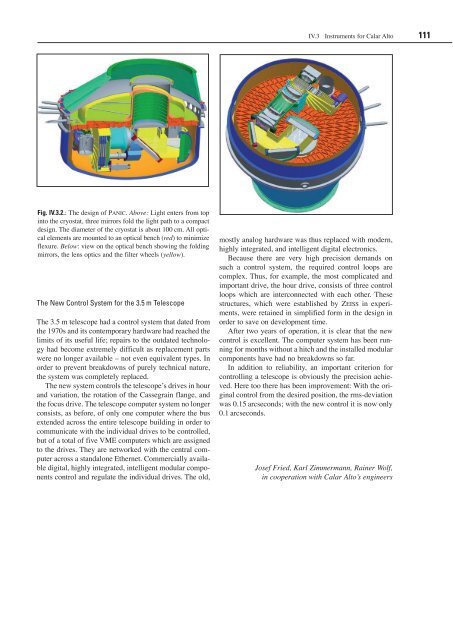Max Planck Institute for Astronomy - Annual Report 2007
Max Planck Institute for Astronomy - Annual Report 2007
Max Planck Institute for Astronomy - Annual Report 2007
Create successful ePaper yourself
Turn your PDF publications into a flip-book with our unique Google optimized e-Paper software.
Fig. IV.3.2.: The design of Panic. Above: Light enters from top<br />
into the cryostat, three mirrors fold the light path to a compact<br />
design. The diameter of the cryostat is about 100 cm. All optical<br />
elements are mounted to an optical bench (red) to minimize<br />
flexure. Below: view on the optical bench showing the folding<br />
mirrors, the lens optics and the filter wheels (yellow).<br />
The New Control System <strong>for</strong> the 3.5 m Telescope<br />
The 3.5 m telescope had a control system that dated from<br />
the 1970s and its contemporary hardware had reached the<br />
limits of its useful life; repairs to the outdated technology<br />
had become extremely difficult as replacement parts<br />
were no longer available – not even equivalent types. In<br />
order to prevent breakdowns of purely technical nature,<br />
the system was completely replaced.<br />
The new system controls the telescope’s drives in hour<br />
and variation, the rotation of the Cassegrain flange, and<br />
the focus drive. The telescope computer system no longer<br />
consists, as be<strong>for</strong>e, of only one computer where the bus<br />
extended across the entire telescope building in order to<br />
communicate with the individual drives to be controlled,<br />
but of a total of five VME computers which are assigned<br />
to the drives. They are networked with the central computer<br />
across a standalone Ethernet. Commercially available<br />
digital, highly integrated, intelligent modular components<br />
control and regulate the individual drives. The old,<br />
IV.3 Instruments <strong>for</strong> Calar Alto 111<br />
mostly analog hardware was thus replaced with modern,<br />
highly integrated, and intelligent digital electronics.<br />
Because there are very high precision demands on<br />
such a control system, the required control loops are<br />
complex. Thus, <strong>for</strong> example, the most complicated and<br />
important drive, the hour drive, consists of three control<br />
loops which are interconnected with each other. These<br />
structures, which were established by Zeiss in experiments,<br />
were retained in simplified <strong>for</strong>m in the design in<br />
order to save on development time.<br />
After two years of operation, it is clear that the new<br />
control is excellent. The computer system has been running<br />
<strong>for</strong> months without a hitch and the installed modular<br />
components have had no breakdowns so far.<br />
In addition to reliability, an important criterion <strong>for</strong><br />
controlling a telescope is obviously the precision achieved.<br />
Here too there has been improvement: With the original<br />
control from the desired position, the rms-deviation<br />
was 0.15 arcseconds; with the new control it is now only<br />
0.1 arcseconds.<br />
Josef Fried, Karl Zimmermann, Rainer Wolf,<br />
in cooperation with Calar Alto’s engineers

















